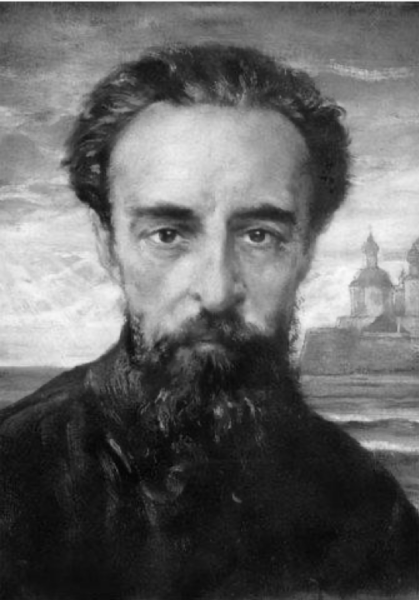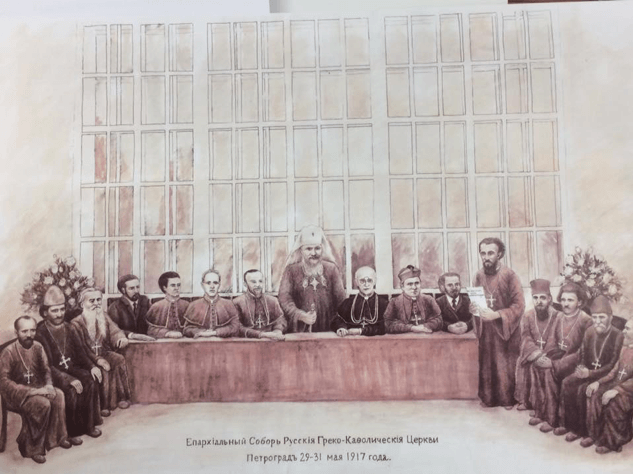Please pray for the author, a convert from Orthodoxy and a third-year Catholic seminarian that he may become a holy Priest and an evangeliser of his Motherland.
From One Peter Five
By Maxim Grigorieff, MA
Part I: What is the Russian Catholic Church? Introduction
Part II: Heralds of a Catholic Russia
Venerable Metropolitan Andrey Sheptytsky (1865-1944)
I would insist here that Venerable Metropolitan Andrey Sheptytsky was head of the remaining western offspring of the once united and Catholic Metropolis of Kiev. The initial canonical unity of newly baptized Rus broke apart in late Middle Ages following the political disintegration and polarisation in the region. After the schism, a once united people were divided between the Sees of Rome, Constantinople and Moscow. The formation of particular nations and their languages in the modern sense (Russians, Ukrainians, Belarusians) was to a great degree conditioned by this history. Metropolitan Andrey lived in the culminating historical moment of all these historical tensions.

Venerable Andrey Sheptytsky
And he acted like a true saint. Out of his Christian solidarity, historic memory and love for the unity of all Kievan Rus under Rome, he was restlessly looking for an opportunity to help the new movement of Russian Catholics receive a canonical form within the Catholic Church. In order to do that, he asked the same Pope St. Pius X for all the necessary powers. In 1908, Father Alexey Zerchaninov was appointed by Rome as the head of a mission for Russian Catholics of the Eastern Rite, directly governed by the Holy See. The Russian Catholic community thus received a canonical foundation and structure, thanks to that prominent Metropolitan of what would be called later a “sister church.”
In 1909, after many attempts to obtain official status, the Russian Catholic Church on Polozov street 12 opened publicly. In 1912, there occurred a need for a new building, as the Church was unable to accommodate all the parishioners. A new chapel was built on the corner of Barmaleyeva Street (house 48/2, apartment No. 1, which does not exist now). In 1913, the Orthodox-Catholic magazine titled ‘The Word of Truth’ began to be published by the parish.
Blessed Leonid Fedorov (1879-1935), the Apostolic Exarch for the Byzantine Rite Catholics in Russia
A significant role in the formation of the Russian Catholic Church of the Byzantine Rite was played by Leonid Fedorov. After graduating from high school, he entered the Orthodox St. Petersburg Theological Academy. The search for truth and the study of church history led him to the conclusion that the Catholic Church is the one true Church. After that, young Leonid went to Lvov, and then to Rome. In Lvov, he met with Metropolitan Andrey Sheptytsky, and that meeting had a decisive influence on his personal fate as well as the future of the Russian Catholic Church. In 1902, in Rome, Leonid officially converted to Catholicism and continued his seminary studies in Rome, Switzerland and Fribourg. In 1911 he was ordained a priest by the Bulgarian Greek-Catholic Bishop Mikhail (Mirov).

Blessed Leonid Fedorov
In 1912 Father Leonid took monastic vows in the Studite monastery in Kamenitsa. In 1914, after his return to St. Petersburg, Leonid Fedorov’s father was arrested and, as a person ‘dangerous to state security,’ was sent into exile in Tobolsk. It was the same year, during the outbreak of World War I, when Russian troops occupied Lvov, Sheptytsky was arrested by the Russian authorities and sent into exile, where he stayed until the spring of 1917.
In early 1917, after the fall of the monarchy, Fr. Leonid and Metropolitan Andrey were faced with the task and duty of putting the affairs of the Russian Catholic community in proper order and reorganising it according to new circumstances.
Meanwhile on May 13th of that year, Our Lady of Fatima appeared in Portugal and would speak about Russia and her conversion. On May 31 (June 11 according to the Russian calendar), the Russian Catholic Synod of St. Petersburg commenced which organized the Russian Catholic Church under Bl. Leonid. In its canons formally submitted:
To the patronage of the Most Holy Queen, our Mother of God who has not shared in Original Sin, all the territory of Great Russia… we beseech the all high to make those dioceses obedient to the Church of Ancient Rome, the Mother of all Orthodox Churches.
Mindful of the words of our Saviour and Lord Jesus Christ: “Pray therefore the Lord of the Harvest to send forth laborers into his harvest” (Matt. 9:38) we beseech Him to grant our Church as great a number as possible of great saints, apostles, martyrs, and confessors for the achievement of the union of all Christian in our Country with the Holy Catholic Church.
Upon all priests is imposed the obligation to beg each day for the favor of this grace.[1]

First council of Russian Catholic Church, May 31 (June 11), 1917. The first solid canonical structure after Isidore: the Russian Catholic Exarchate in St. Petersburg
As a priest, Leonid Fedorov was made “Exarch” of the Russian Catholic Church. He was endowed with almost episcopal powers and received the title of a mitred archpriest.
As a result of the Council there were sixty-eight points of resolutions agreed upon that answered the most pressing questions of structural and spiritual life of the flock and clergy. Particular attention was paid to the inviolable formal integrity of the Russian Slavic-Byzantine rite, according to the will of Pope St. Pius X, who personally ordered that the Russian rite be kept unchanged: ‘nec plus, nec minus, nec aliter’ – ‘without additions, omissions or changes.’ In 1921, the Holy See officially confirmed the appointment of the Exarch. After the Council, many parishes were being established, new priests were sent to them by the decision of the Exarch, and educational and charitable activities were developing very rapidly. Among other projects, ‘The Society of the Advocates for the Reunification of the Churches’ was formed, consisting of Orthodox and Catholics alike. A small female monastic community dedicated to the Holy Spirit was founded in St. Petersburg with the number of the faithful growing.
In one of his letters, Fedorov wrote:
From the very beginning of my activity, I managed to establish the most friendly relations with the most prominent representatives of the Petrograd [= St. Petersburg] clergy like Metropolitan Veniamin, Bishop Simon [of the Old Believers in communion with the Russian Church], and even with the Patriarch himself.
In 1920, Russian Orthodox Patriarch Tikhon allowed the Orthodox clergy to work together with the Eastern Catholics on the issue of re-establishing the long desired unity between Greeks and Latins.
Vladimir Abrikosov (1880–1966), Russian Catholic priest in Moscow
In parallel with the community of St. Petersburg, another group of Russian Catholics was developing in Moscow under the leadership of the spouses Anna and Vladimir Abrikosovs. Ordained during the Council of 1917, Fr. Vladimir became the pastor of the freshly-established parish dedicated to the Nativity of the Most Holy Theotokos. A female monastic community of the Byzantine rite and Dominican spirituality was also established in the city.
Next week, part IV: Enter the Soviets
[1] “The Synod of Petrograd” (1917), Canons, 9-11, published with permission from archivist Rev. Ussas in The Ark (Aug-September, 1953), vol. 8, no. 8-9.
No comments:
Post a Comment
Comments are subject to deletion if they are not germane. I have no problem with a bit of colourful language, but blasphemy or depraved profanity will not be allowed. Attacks on the Catholic Faith will not be tolerated. Comments will be deleted that are republican (Yanks! Note the lower case 'r'!), attacks on the legitimacy of Pope Leo XIV as the Vicar of Christ, the legitimacy of the House of Windsor or of the claims of the Elder Line of the House of France, or attacks on the legitimacy of any of the currently ruling Houses of Europe.